August 24, 2022 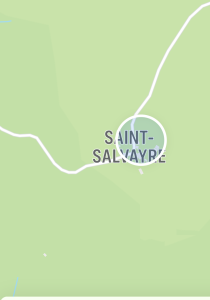
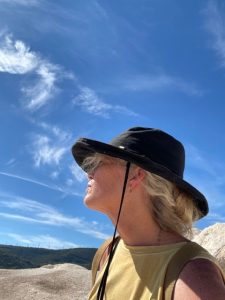
✧ * . * ✧ . * . *
. * . * . m y s t e r y . ✧ .
✧ ✧ * . * . . *. m a g i c .
✧ * .m a g d e l a . ✧ . * . * .
The last time I visited Saint-Salvayre was before times, in the fall of 2019. I’ve been contemplating this day for so long, yearning to be here, pulled to being here. And as Sir Henry Lincoln (‘Holy Blood Holy Grail’) said to me that day inside the church as he was sitting quietly next to the ancient standing stone, “This is a very special place.” I captured Henry as he was leaving the church in the small hamlet of Saint-Salvayre near Alet-les-Bains.
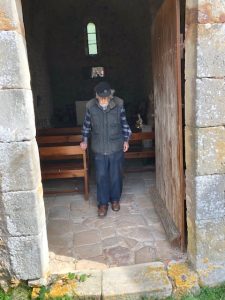
Sir Henry died this year on February 24th. He was 92. How I wish I could meet up with him where he lived at Rennes-les-Bains and talk all things Mariam of Magdala and her journeys with Yeshua in the Languedoc region of France. I have so many more questions and perspectives to share. More than that, just to listen to him speak of this history, where ever he chooses to take the listener. “Don’t look, see.”
When I visited this tiny, ancient church/Roman resting place on my first visit, we were in a small van. I had no recollection how vertical! the journey was. I remember reading recently about Roman garrisons lighting fires in St. Salvayre to alert chateaus in the surrounding area thinking, how could they see it, it is not very high. And when I heard people drive up to the hamlet to watch the Bastille Day fireworks being displayed in Carcassonne, I thought, but isn’t that high, so maybe the open space? Now I know. The views of the Pyrenees are spectacular; just the general splendor of the entire region is on display on the long hike up. The path is six kilometers from Alet-les-Bains and it’s all vertical. I read recently where someone had shared it was a ‘comfortable hike.’ My take? A little different. Some thought processes today in the 95 degree heat…going up.
Starting point: If I lived here, I could climb this every morning for prayers and meditations.
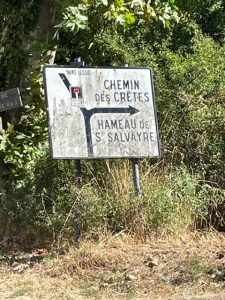
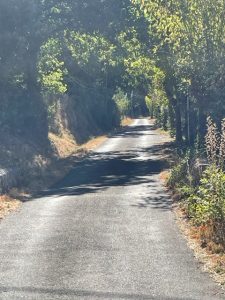
1/4 way up: maybe once a week.
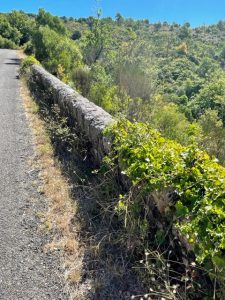
1/2 way up: maybe twice a month.
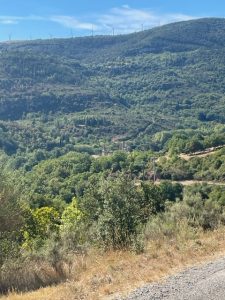
3/4 way up: maybe just once a month.
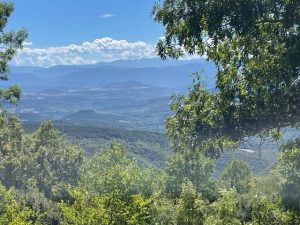
Almost there: definitely need a Vespa.
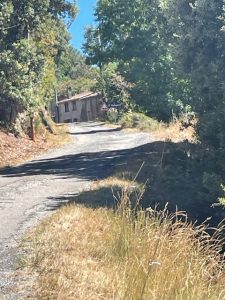
Seeing the sign…f i n a l l y. So happy.
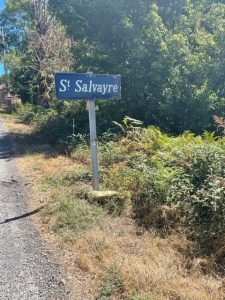
And then, there it is.
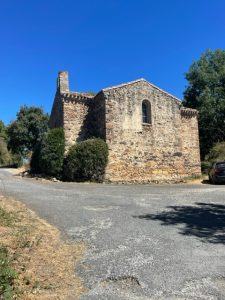
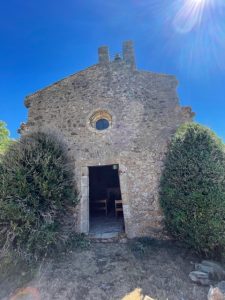
Pausing, reflecting, and centering before entering.
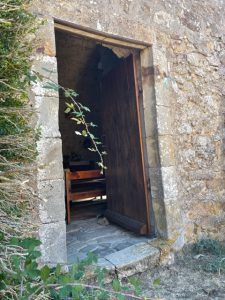
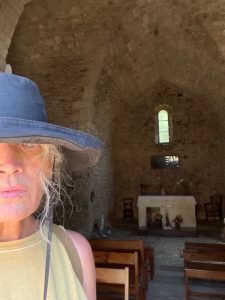
Gratitude and grace for surviving the plague and being given the gift of returning to this sacred and magical place, Saint-Salvayre. Indeed, as Sir Henry shared, a very special place, from the shrines to Mary Magdalene, to the painting of Yeshua, still living, being helped from the cross by St. Francis. The messages, the meaning, and the mystery. It’s all of it: the history, the sacred geometry, and the ancient standing stone, where it seems the structure was actually built around.
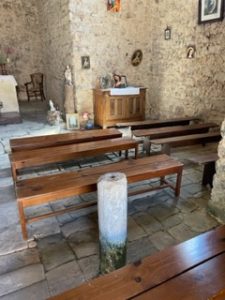
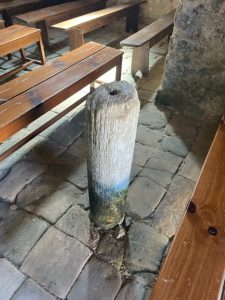
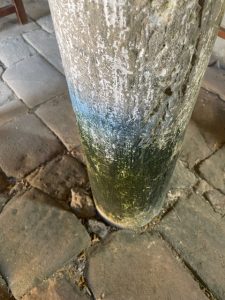
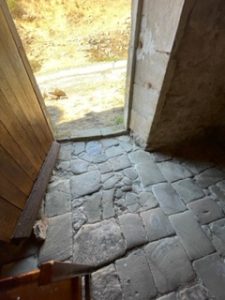
The stones, the shapes, their placement, all speak to ancient Roman times. Where this structure is placed could once have been a pagan place of worship. Then, in later centuries, a new structure built in the shape of St. Andrew’s cross. The Templars were reportedly here (Baphomet), and it was a place of refuge for Cathars.
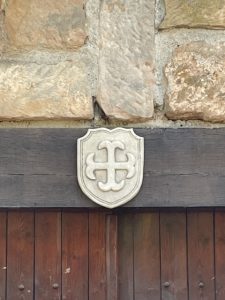
Cathar cross.
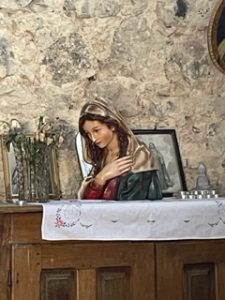
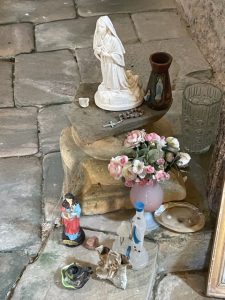
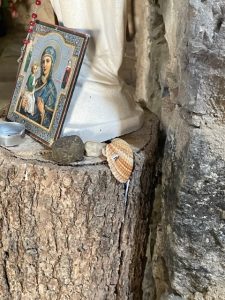
And here, a shell. Was this left by a pilgrim on their way to the Camino de Santiago de Compostella?
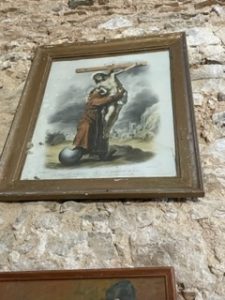
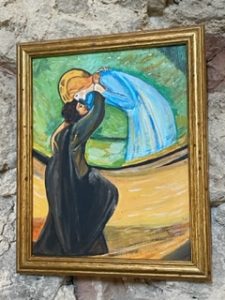
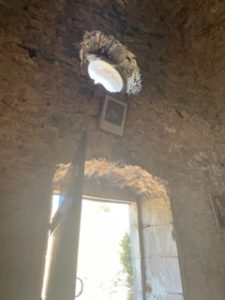
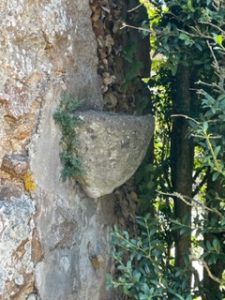
A small ancient water basin outside the door of the church discovered behind thick foliage.
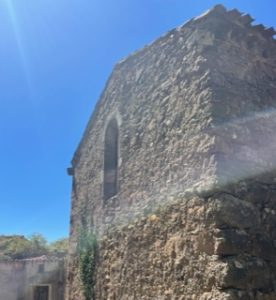
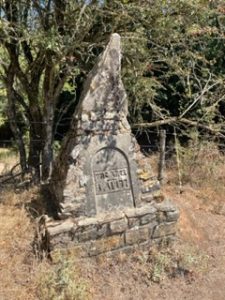
A marker outside of the church, just up to the left. The markings look Greek, or Egyptian. I haven’t been able to locate any information about this stone piece.
I tried to locate the twin trees and other standing stone about 1.5 kilometers away, but couldn’t find it this time. It’s been three years and there’s so much undergrowth and with COVID, very few visitors. I really tried.
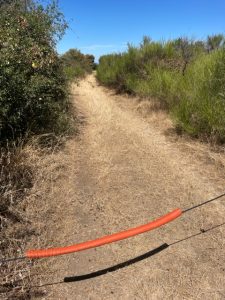
I don’t remember the barrier there; climbed over.
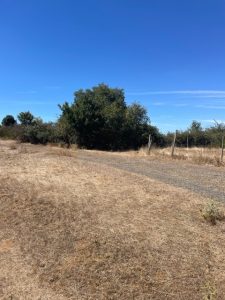
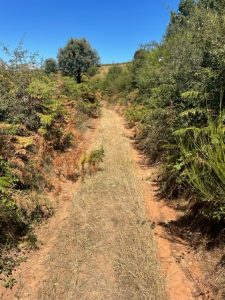
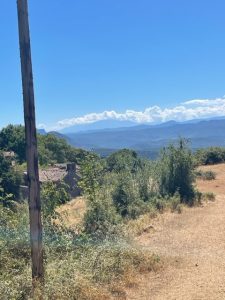
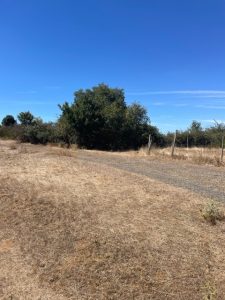
By then, my feet were hurting so badly from the climb…blisters.
So after one more repose inside Saint-Salvayre, I started the climb down, grateful to use a different set of leg muscles, although my poor pieds, pas bon.
I stopped at one point on a hill of natural limestone to find Rennes-les-Chateau in the distance…sacred geometry.
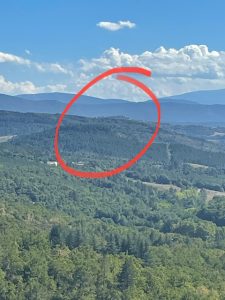
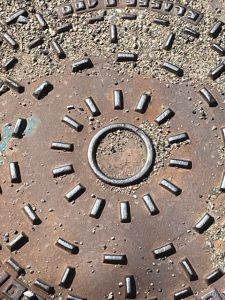
Light. It’s everywhere. We just have to see.
I loved today.
Bonne nuit.
🔆
January 12, 2022 Father Richard Rohr
Center for Action and Contemplation
Once we allow the entire universe to become that alive and dynamic, we are living in an enchanted world. Nothing is meaningless; nothing is able to be dismissed. It’s all whirling with the same beauty, the same radiance. In fact, if I had to name the Big Bang in my language, I’d call it the Great Radiance. About 13.8 billion years ago, the inner radiance of God started radiating into forms. All these billions of years later, we are the continuation of that radiance in our small segment of time on this Earth. We can either allow it and let the Infinite Flow flow through us, or we can deny it, which is really what it means not to believe.
This is not something I can prove to anyone. This is nothing I can make logical or rational. It’s only experiential, and it’s only known in the mystery of love when we surrender ourselves to it, when we grant the other inherent dignity and voice—the plant, the animal, the tree, the sky, Brother Sun and Sister Moon as my Father Francis of Assisi put it.
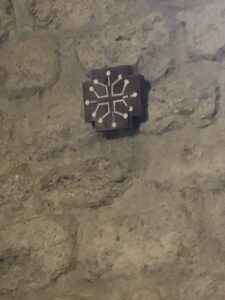
Beguines, the ‘world’s oldest women’s movement…’
NYTIMES
Some historians believe they banded together after losing their men to the Crusades, which left behind mainly criminals and louts — beguines were not confined to the cloister. Many ministered to the poor and sick outside their walls. Lifelong celibacy was not required either. They could leave the order and marry (but not return).
Traces of these remarkable women and their idiosyncratic spiritual ways can be found today in the urban islands of quietness they once called home. Known as beguinages or begijnhofs, several dozen of these compounds are still intact (to varying degrees) from England to Germany. Ten years ago Unesco declared a select group as World Heritage Sites. No country has more beguinages (29) than Belgium, and a trip to inspect a few in three cities seemed like a pleasant way to spend a spring day, especially given the ease with which one moves by train in that convenient nation.
In its modesty, this beguinage is reminiscent of a poorly endowed college at Oxford. The bourgeois values of peace and tidiness govern all beguinages, elements that look forward to the airy clarity of the Enlightenment rather than back to the Gothic sublime of the Middle Ages.

These were “independent women who defined for themselves what it meant to live according to gospel values. Beguines were not nuns. They used their sources of income to purchase homes near the chapel or parish church where they gathered together for prayer. They emerged in the midst of a so-called first renaissance when European society was transforming itself from a narrowly defined structure of a great many peasants.
Several factors propelled this renaissance and supported the emergence of the beguines, including the Crusades and courtly culture, emerging cities and their fledging universities, a new money-based economy, the growth of lay spirituality and the cult of the Virgin Mary, as well as new monastic orders.
Additionally, there was a phenomenon called vita apostolic, which means the ‘apostolic life’ or ‘the life of an apostle.’ Beguines were a powerful expression of the vita apostolica.
Leading profound simplicity, beguines pooled their resources in order to serve the sick and destitute by building and operating infirmaries and almshouses.
- Hildegard of Bingen
- Heloise
- Marguerite d’Oingt
- Gertrude of Helfta
And many women became beguines as a result of their newfound literacy.
A heretic is a person who allegedly corrupts established faith doctrine, often by selecting a limited set of beliefs and denying the other parts of orthodox teaching.
It was a highly charged political environment in the medieval world.In a society strongly defined by each person’s specific place (such as belonging to the guilds or merchants, to aristocratic or religious classes or the the peasantry), beguines were violating their ‘God-assigned place’ in order to serve the gospel.
Beguines were under church investigation at different ties and in different parts of Europe for their spiritual independence.
While most beguines were quite orthodox, there were some religious laywomen who did join the Cathars, the Free Spirits, The Spiritual Franciscans, and other suspected heretical movements.
Most challenges of heresy, however, were politically motivated. When beguines challenged inept clergy, they made priests and bishops angry. When beguines condemned the red and corruption within the church, they made the church hierarchy angry. When beguines denounced the cruelty done to innocent laypeople through interdict, they made the popes angry. Beguine preaching would always make some men in power angry.
Beguines showed great strength and persistence and collaborated with fellow seekers, tolerated diversity, and raised difficult questions; they exercised both communal and personal wisdom and freedom to follow God as they felt called.
The story of the beguines affairs that women have contributed far more to spirituality and culture than history books have traditionally acknowledged. Their voices proclaim a divine presence that years for relationship with each of us.
These medieval women offer us hope and a fresh path: to think creatively, to collaborate to achieve change, and to live with prophetic courage.”
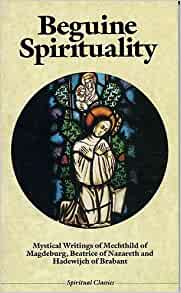
“A movement, rather than an order, there was no single style or pattern of beguine life.
While reacting against the wealth and ostentation of secular society, the beguines did not see poverty as an end in itself, rather they encouraged the development of the virtues of charity, humility and companionship.
Beguines worked in hospitals, visited the sick in their homes and established infirmaries.
As the church became increasingly paranoid concerning the presence of heterodox teachings, and brutal it its attempt to eradicate those it conceived of a threat, beguines, along with Jews, witches and various other sects, found themselves vulnerable and subject to frequent accusations of heresy, with often terrible consequences.”
~
The French mystic Marguerite Porete was burned at the stake in Paris in 1310, after a year and a half of imprisonment. Her crime was to repeatedly refuse to appear before the court of the inquisitorial commission to answer charges relating to her book, The Mirror of Simple Souls. During her trial, she refused to swear the oath required of her by the inquisitor’s office and she showed no remorse for having violated an injunction to withdraw her book from circulation after it had been publicly burned several years previously. Many who witnessed her execution were said to be moved to tears by her piety.
Little is known about Porete, apart from the record of her trial and what can be gleaned from her writings. It seems likely that she was associated with the beguines, a women’s religious movement which spread across northern Europe during the 13th and 14th centuries. Although the beguines devoted themselves to charity, chastity and good works, they took no religious vows and their lifestyles varied greatly, from solitary itinerants (of which Porete was probably one) to enclosed communities. The beguines were part of an era of vigorous spiritual flourishing during the Middle Ages. They were condemned by the Council of Vienne (1311-1312), which also condemned the Free Spirit Movement with which they were sometimes (and probably erroneously) identified. Although the beguine movement declined dramatically in the 15th century, some beguine communities survived until the early 20th century. The beguinage in Leuven in Belgium is a Unesco world heritage site, and to wander through its quiet cobbled roads and enclosed gardens is to feel a poignant sense of the lost history of women’s lives.

~
And this, by Allysha Lavino…recommend highly.

My review from 2020 for Amazon, Trust the Magic:
What did you see today?
What did you learn today?
What did you love today? (p.79)
Henry Lincoln chose to See, and now, Allysha has chosen to See with the eyes and wisdom of the Divine Feminine in The Heretic. Having both discovered their place in the universal pattern, Allysha invites us through beautiful and brilliant storytelling to find our own place through sacred geometry while meeting the Good People, the ancient Cathars, in Southern France. Reading The Heretic, I had the remarkable context of a Sacred Mystery Tour with Allysha and her husband, Mark, co-led by Sir Henry, to visit the sites revealed in the Languedoc region of Southern France. My hope is that if you’ve landed in this virtual space—”nothing is done par hazard” (p. xv)—either directed by the Divine Feminine or a passionate friend, you, too, will be called to physically explore the ruins and profound spiritual places Allysha excavates in the pages of The Heretic. If not, this book will be your experience. Allysha has magically captured through character and compassion the Wisdom resting beneath all things, the dualism of good and evil. During this time of pandemic and global social sadness, Allysha reminds us through her ancient research and inspired writing that suffering cannot destroy us, beauty is in everything, “though the world around us was filled with the shear chaos of the unknown” (p. 217). She gently encourages us in her story to “trust the magic,” as she gathers what Emily Dickinson called the fruits of the spirit: patience, kindness, gentleness and self-control. It is Lily’s discoveries along with her young ethereal guides at the old hotel in Alet-les-Bains who encourage us to charge the awakening. I didn’t want this book to end—gratitude to Gaia it is a trilogy! Allysha, “thank you for your wisdom…your joy…your peace…your guidance…your strength…your love (pp. 265-266). As Henry writes in his Forward, “The world has been preparing Allysha for this task for years, unbeknownst to either of us.” Baphomet, friends…the path awaits.
Author Beatrice Bruteau [1930–2014]: “We need a new theology of the cosmos, one that is grounded in the best science of our day, so that all the world turns sacred again.”
-Dayle Ohlau

October 20, 2020 
“Darkness can come in many forms, sometimes fast, sometimes creeping slowly. Ours came at warp speed and was all-encompassing when our son, Matthew, was brutally murdered 22 years ago simply for being gay.
One minute we were a family of four, the next, we were three. We were experiencing so many emotions – anger, confusion, grief and a sense of emptiness — all at once.
As time passes, light finds a way, in many ways, sometimes fast, sometimes creeping slowly. Our light was family and friends, both known and unknown. We had found a new community who loved without judgement and welcomed us with open arms.
Darkness, however, is never far away. Darkness demands your attention, but after seeing the light you can leave the darkness where it is and not embrace it.
Sadness is present every day. It is an ache, an emptiness, a loss of what you thought your life would be. Maybe sadness is a recovery from darkness; that recovery may well last the rest of your days. However, you can be sad and still function. Functioning is surviving your darkness and your sadness. Functioning is finding a purpose to still be present.
The next step is the joy you find from serving your purpose, from helping others in a way that speaks to your heart. Everyone is going through their own particular pain. You may not see it—they may not want to talk about it but it is there. Joy is especially welcome when sadness has been your overriding emotion.
Even joy can be interrupted by an unexpected memory – a scent, a song, even a shadow can awaken the sadness. But now you know you can survive it. You can even embrace the memories, feel the sadness and return to joy.”
Judy Shepard
Gay rights activist and mother of Matthew Shepard, who was interred at the Cathedral in 2018, 20 years after his murder that galvanized the gay rights movement
The prayer of St. Francis:
Lord, make me an instrument of your peace
Where there is hatred, let me sow love
Where there is injury, pardon
Where there is doubt, faith
Where there is despair, hope
Where there is darkness, light
And where there is sadness, joy
O Divine Master, grant that I may
Not so much seek to be consoled as to console
To be understood, as to understand
To be loved, as to love
For it is in giving that we receive
And it’s in pardoning that we are pardoned
And it’s in dying that we are born to eternal life.
The Prayer of St. Francis describes a world—and a state of being—that is often the one we strive for but rarely see. Where there is hatred, we instead find love; where there is injury, pardon. It describes an active faith, one that is shaped and reshaped and constantly striving toward perfection. – The St. Francis Project
stfrancisproject.org
January 28, 2020 One spirit, at work in each, becomes their guide, led by more than mere human communication. -Day by Day with St. Francis
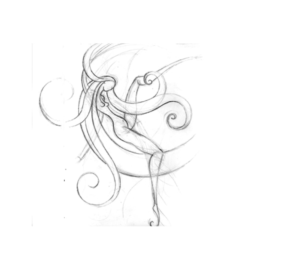
‘The primacy of love allows our knowing to be much humbler and more patient and helps us to recognize that other traditions—and other people—have much to teach us, and there is also much we can share with them. This stance of honest self-knowledge and deeper interiority, with the head (Scripture), the heart (Experience), and the body (Tradition) operating as one.
Contemplation allows us to see things in their wholeness and thus with respect (re-spect means to see a second time).
Only at a deeper level of contemplation do we begin to see the correlation between how we do anything and how we do everything else. We take the moment in front of us much more seriously and respectfully. We catch ourselves out of the corner of our eye, as it were, and our ego games are exposed and diminished.
Such knowing does not contradict the rational, but it’s much more holistic and inclusive. It might be called trans-rational although many think it is pre-rational. It goes where the rational mind cannot go, but then comes back to honor the rational, too…“contemplative epistemology”—a contemplative theory of how we know what we know.’
-Fr. Richard Rohr
October 6, 2019 Ghandi recognized, as no other world leader of our time has done, the necessity to be from from the pressures, the exorbitant and tyrannical demands of a society that is violent because it is essential greedy, lustful, and cruel.
He recognized the impossibility of being a peaceful and nonviolent man, if one submits passively to the insatiable requirements of a society maddened by overstimulation and obsessed with demons of noise, voyeurism, and speed.
Gandhi believed that the central problem of our time was the acceptance or the rejection of a basic law of love and truth which had been made knows to the world in traditional religions.
His whole, his political action, finally even his death, were nothing but a witness to this commitment: “If love is not the law of our being, the whole of my argument falls to pieces.”
-Thomas Merton, Seeds of Destruction
The most inward and loving of all,
he came forth like a new beginning,
the brown-robed brother [St. Francis] of your nightingales,
with his wonder and good will
and delight in Earth.
Rilke, The Book of Hours III, 33
This is the miracle of love: to discover that all creation is one, flung out into space.
[…]
This is the principle of nonviolence, and I want to recommend it to you with all the enthusiasm I can command. . . .
If human beings go to war, it is because they fear someone.
Remove the fear, and you re-establish trust, and will have peace.
Nonviolence means destroying fear.
-Fr. Richard Rohr, Center for Action & Contemplation
Power does not corrupt. Fear corrupts… perhaps the fear of a loss of power.
—John Steinbeck, The Short Reign of Pippin IV (1957)

September 2, 2019
Admonitions, 27:
Where there is charity and wisdom there is neither fear nor ignorance.
Those who live in love have a wisdom about them, particularly in their sense of priorities. They know what is important.
Day by Day with St. Francis:
Those who are fearful see things that aren’t there, and tend not to grasp the truth when it is presented to them.
In love there is no fear; indeed, perfect love casts out fear.
1 John 4:18
‘Occasional churchgoing and the recitation of has prayers have no power to cleanse this purulent wound.’ -Thomas Merton, No Man Is an Island
‘Lord, the great cities are lost and rotting.
Their time is running out…
The people there live harsh and heavy,
crowded together, weary of their own routines.
Beyond them waits and breathes your earth,
but where they are ti cannot reach them.
They don’t know that somewhere
wind is blowing through a field of flowers.’
-Rilke, The book of Hours III, 4/5
♡
My campaign for the presidency is dedicated to this search for higher wisdom. Its purpose is to create a new political possibility in America — where citizens awaken, our hearts and minds are uplifted, and our democracy once more becomes a thing about which we can all feel proud.
This is a new time, and we must bring forth something new within ourselves in order to deal with it. In the words of Abraham Lincoln, “As our case is new, so we must think anew, and act anew. We must disenthrall ourselves, and then we shall save our country.”
June 25, 2019 
‘The Golden Rule is so basic, so logical, so easy to agree with, yet so utterly difficult to practice! One way to start is to simply put ourselves in the other’s shoes, to practice empathy and sympathy. Practice is really the operative word, for empathy does require practice. It takes many intentional efforts before we can make it a habit.’
Day by Day with St. Francis, by Peter A. Giersch [2015]
~
If we just keep hold of each other, you grasping the young one and I the old, we could revolve together like ´*.¸.• .¸. ¸.☆¨ .¸.¸¸.☆’s.
New Poems, by Rainer Maria Rilke
February 14, 2019 
“The entire universe is about connection and relationship…from the smallest atom to the galaxies and everything in between. Sin (missing the mark) and evil (false awareness) emerge when we try to stand outside of that circle of connection.”
-Fr. Richard Rohr, Center for Action & Contemplation
~
St. Francis, while looking at the stars one night:
If these are the creatures, what must the creator be like?”
November 27, 2018

The Franciscan Way
Fr. Richard Rohr:
“Because Francis was not an intellectual, he did not begin with universal philosophies and ideas and abstractions. He began with the specific, the particular, the concrete: this person, this squirrel. I believe love is always, by its very nature, particular. “Just this!” When you start with the specific, you have a beautiful doorway to the universal. On the other hand, when you start with universal theories, it makes it very hard to ever get back to respect for the particular. In fact, you tend to find a reason to see that the particular is never good enough. It is always flawed and imperfect. There is inevitably a reason why this particular person or thing cannot be included, because it is seen to be abnormal, poor, broken, leprous, sinful, or unorthodox. Look at our Christian history: it seems to have been a nonstop search for who is unworthy and who does not belong. What a horrible waste of energy.
Walter Brueggemann says the entire biblical revelation is built on “the scandal of the particular.” Get it in one ordinary, concrete moment. Struggle with it there, fight with it there, resist it there, fall in love with it there. It’s a scandal precisely because it’s so ordinary. What is true in one place finally ends up being true everywhere. This is especially clear in the sacrament of the Eucharist. The Eucharist offers one focused moment of truth, showing that the Christ and this ordinary bit of elemental bread are one, and therefore the spiritual and the material can apparently coexist. Struggle with that, resist it, fall in love with it, eat it. You can’t just think about it rationally in your mind. Spiritual things are known in a whole-body way. You know them with your body, heart, soul, and mind all operating together. In this mysterious sacrament of Eucharist, you eat the bread; it becomes one with you; you become one with all those around you who are the same Body of Christ. It’s a corporeal, cellular knowing. The bread is for the sake of the people, it is food for the sick and weary, a medicine for the soul to let people know that they are what they eat! Instead, as Pope Francis says, we made it into a distant “prize for the perfect,” and its transformative and healing power was lost.”
Gateway to Silence:
“I am who I am in the eyes of God, nothing more and nothing less.” —Francis of Assisi

September 11, 2018 ‘Only wisdom confounds Satan and all his wickedness. Pure holy simplicity confounds all the wisdom of this world and the wisdom of the flesh.
-St. Francis, Salutation of the Virtues
Prayer: The wisdom that comes from above is first of all pure, then peaceable, gentle, and considerate, full of mercy and good fruits, without any trace of partiality or hypocrisy.
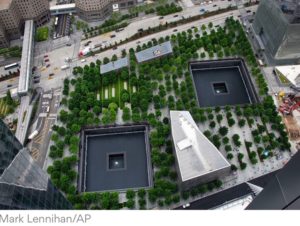
[photo: 9/11 memorial in NYC captured from above]
9.11
3,000 died that day, and many more since the terrorists struck, the first responders and those who stayed for weeks and months trying to repair the city.
The Guardian
September 11: nearly 10,000 people affected by ‘cesspool of cancer’
By Erin Durkin in New York
“Tens of thousands of people who lived or worked in the neighborhood at the time found themselves breathing in air thick with toxic fumes and particles from the pulverized, burning skyscrapers. Many have since become sick, many have died and new cases are still occurring all the time that are linked back to the poisons that were in the air around the wreckage.”
https://www.theguardian.com/us-news/2018/sep/10/911-attack-ground-zero-manhattan-cancer
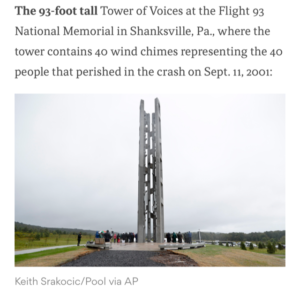
“Yes, it still hurts, and we still mourn. Our beliefs do not change the fact that we suffer from the experiences of our human existence. We should mourn our dead and feel horror at violence. We should seek justice, commemorate the bravery of first responders and honor the sacrifices of the many people who pulled together in countless small ways to comfort and support each other.
As metaphysicians, however, we do not stop there. We set our eyes and hearts to looking beyond what happened to what can come from it. For there is always something good that can be belated, whether or not we can see it in the moment. There is always love, showing up in ways big and small. We saw it for days, weeks and months after 9/11. Surely, we can keep that movement going even after 17 years. As for me, I intend to feel the pain, honor the courage, seek the path to forgiveness the best I can and always, always return to love.”
Affirmation: I remember those who died, those who save others and those who were so misguided on this day 17 years ago. I hold them all in my heart and remember that I am one with them all in the One.
-Rev. Katherine Saux, Science of Mind
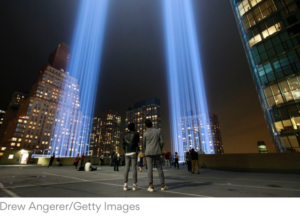
September 10, 2018 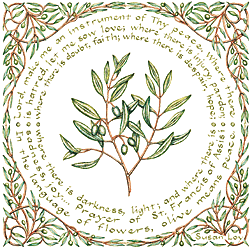
“The whole of humanity, “forms, so to speak, a single living being.” In Christ we form a single body, we are all “members of one another.” For the one flesh of humanity and of the earth “brought into contact” in Christ “with the fire” of his divinity, is henceforward secretly and sacramentally deified.”
Olivier Clément, The Roots of Christian Mysticism, 2nd ed. (New City Press: 2013), 46.
“Even science confirms that there is no clear division between matter and spirit. Everything is interpenetrating. As Franciscan scientist and theologian Ilia Delio often says, “We are in the universe and the universe is in us.” Christ’s very nature mirrors this universal reality, that we are all one, just as he is one within himself.”
-Richard Rohr, Center for Action and Contemplation
~
Presence of Spirit Everywhere, Dr. Ernest Holmes
The Spirit of God, which is Life, is present everywhere. Like the air we breathe, It presses against us. On the mountaintop, in the valley, in the desert, and in the ocean–there is no place where Life is not. Therefore, in whatsoever direction we move, we move in God. In God we live, move, and have our being.
God is one undivided and indivisible Wholeness, one divine and spiritual Presence, our universal and all-encompassion Person. Perhaps it is a little difficult for us to understand the meaning of such an all-inclusive Person, but the very fact that we are personalities presupposes such a conclusion. Our endeavor, then, is not so much to find God, to discover the Divine source of our personal being, as it is to become acquainted with God.
Today, I consciously commune with the Spirit. I know that it presses against me and flows through me. I endeavor to feel this presence as a living reality in my life. Knowing that the Divine Presence is in everyone, I sense that the Spirit is in everyone I meet. I do my best to respond to this Spirit. Seeing It everywhere, I keep my consciousness open and alert that I may better understand the union of all life with its pure and perfect Source.
~
‘There is no one in this world who is not looking for God. Everyone is trudging along with as much dignity, courage and style as the possibly can.’ -Hafiz
“It’s nice to know we are all looking for God. It’s nicer still to know that we can find God in each other. After all, we’re all doing the best we can, with as much courage and style as we can. […] I have truly found that judgments, which are usually condemnations, are built on assumptions. And assumptions are built on quicksand–they suck up my good sense and my loving heart, so that as I drag someone down, I go down, too.”
-Rev. Katherine Saux, Science of Mind

He who possesses one [of the virtues] and does not offend the others, possesses all; and he who offends one, possesses none and offends all; and every one of them confounds vices and sins.
-St. Francis of Assisi























































